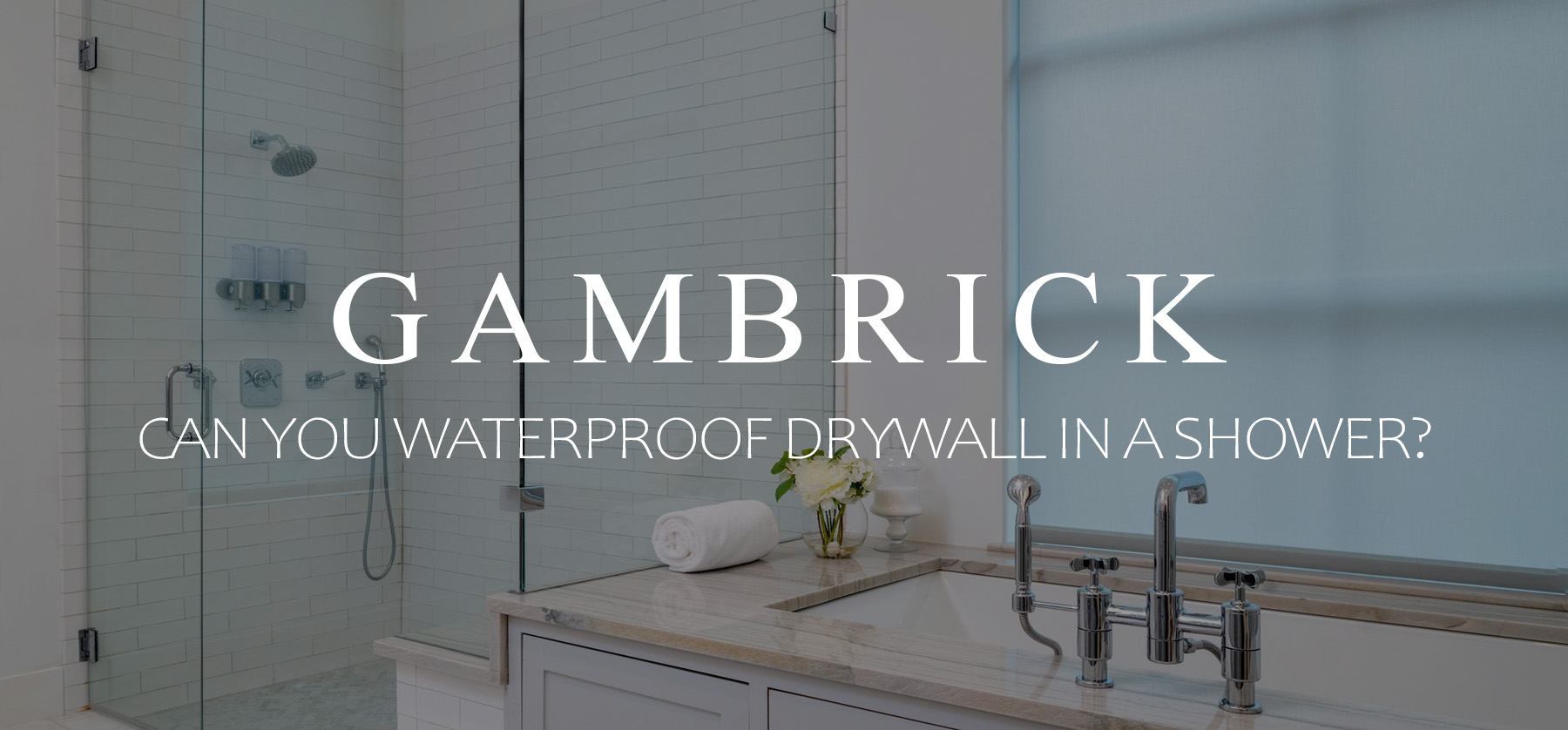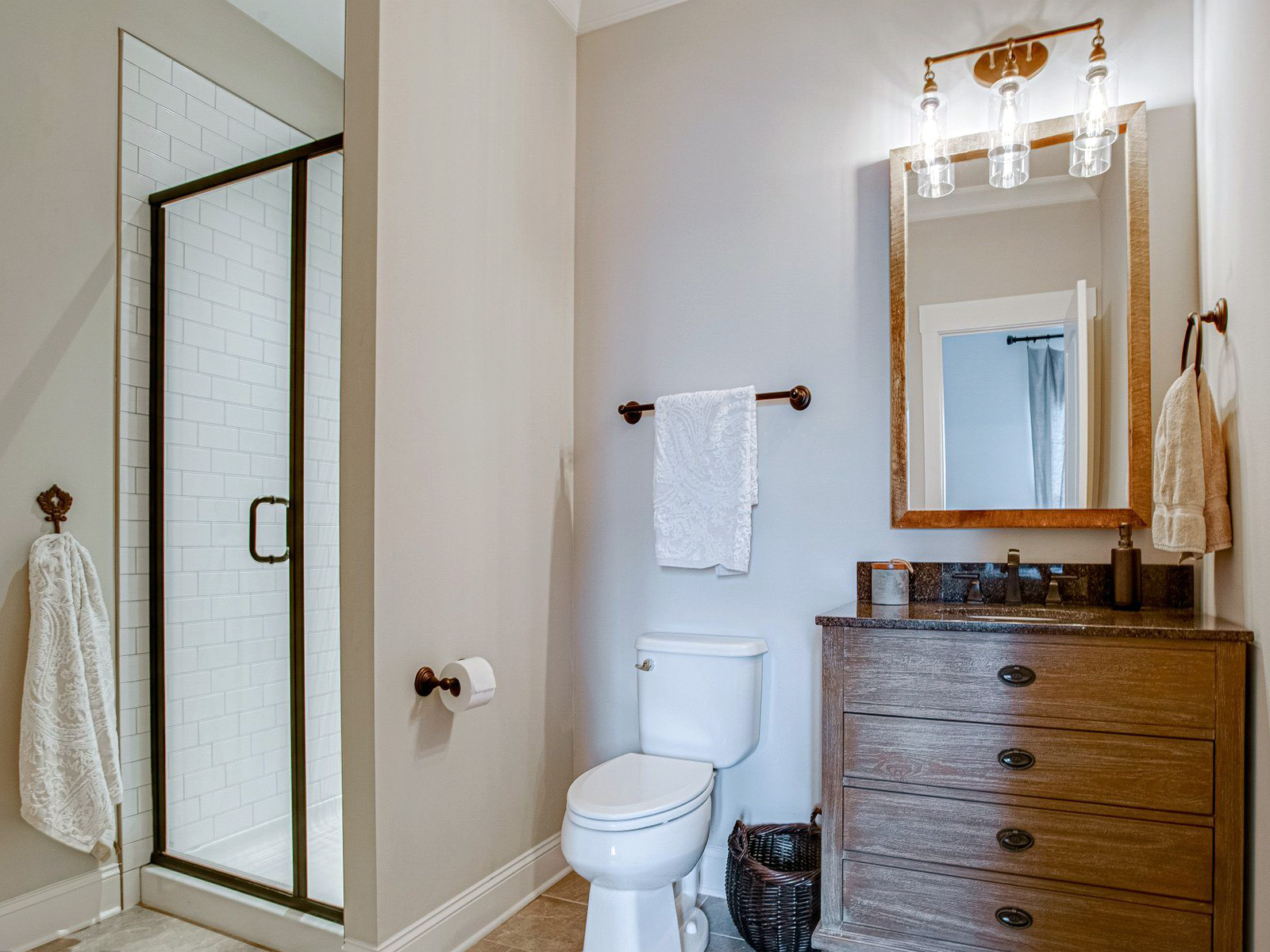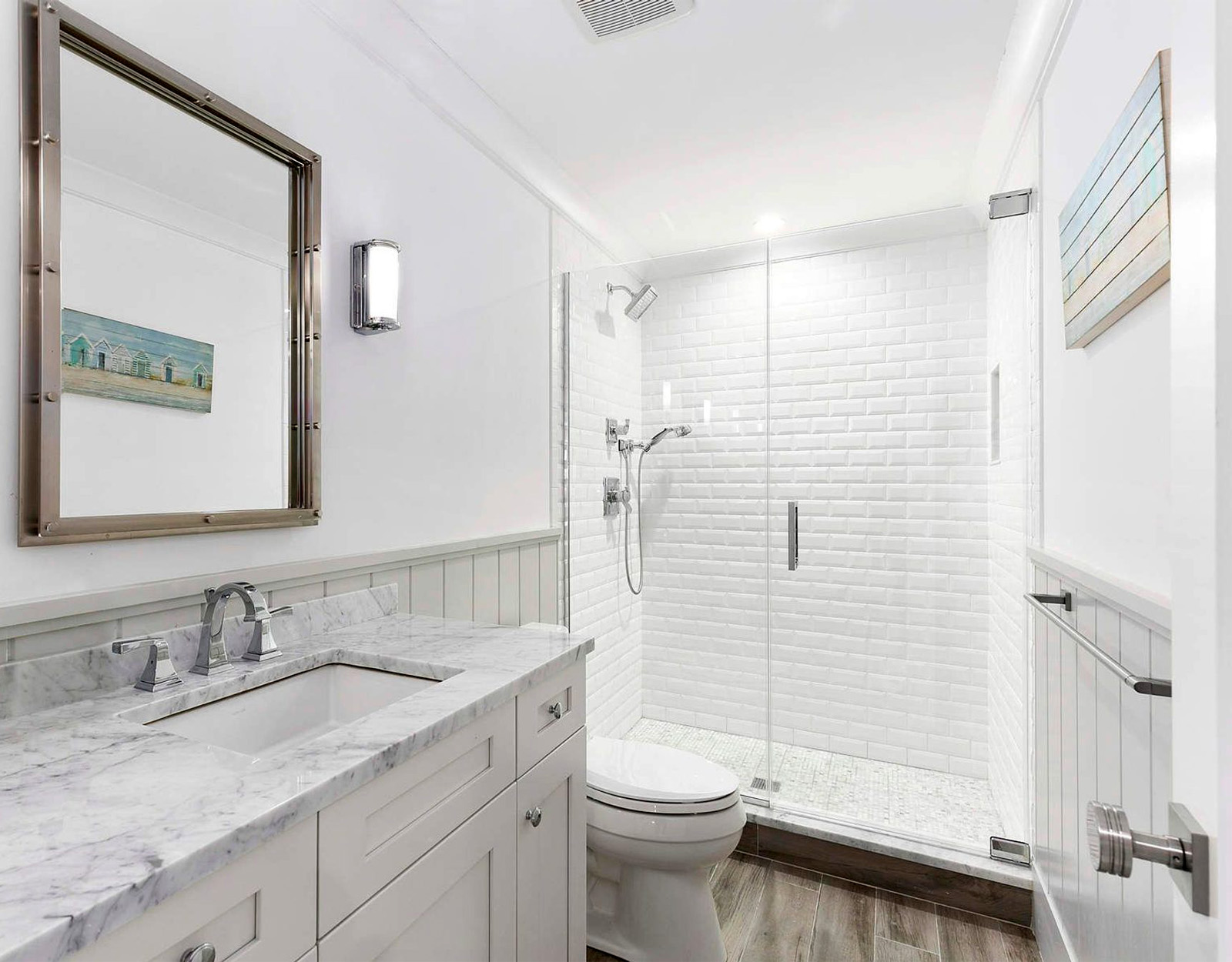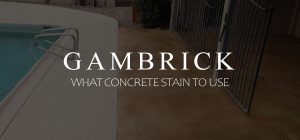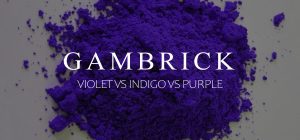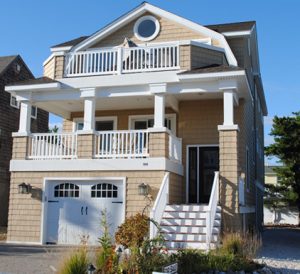Can You Waterproof Drywall In A Shower?
Drywall in a shower can’t be made waterproof. Use cement board with a waterproof membrane like RedGard instead of drywall in showers and other extremely wet areas. However drywall can be made water resistant by using a liquid waterproofing membrane, a roll membrane or a water resistant primer. A liquid waterproofing membrane helps prevent drywall from pulling moisture out the thinset which causes it to dry too quickly. A water resistant primer comes as both an oil and latex based paint. They’re created specifically to prevent mold and mildew from growing on drywall. A roll membrane creates a barrier between the water and drywall to keep it dry. All of these products make drywall more water-resistant. But not water-proof.
There’s no way to make drywall 100% waterproof. Even green drywall, which is designed to be water resistant, isn’t waterproof. Green board resists rot, mold and mildew growth. But if it gets extremely wet all these things can still happen and worse. When moisture works its way into a drywall sheet’s center, it can completely deteriorate the material and grow mold.
If you’re tiling over drywall in extremely wet areas like a shower, use cement board with a waterproofing membrane on top. Don’t use drywall in wet areas like showers or around tubs.
It’s generally OK to use drywall high above or around a shower in areas that don’t get very wet. Drywall can resist surface level moisture like steam if it’s made water resistant by using a primer or liquid waterproofing.
You can tile over drywall in areas that don’t get too wet. I recommend using green drywall with a waterproofing membrane or primer followed by tile, grout and caulked edges.
If you take the proper steps shower drywall can be made water resistant, but not 100% waterproof.
Can You Make Drywall Waterproof In A Shower?
No, there’s no way to make drywall 100% waterproof in a shower. But you can make it water resistant by covering it with a liquid waterproofing membrane, a roll membrane or a primer.
Where the drywall is located in the shower will dictate which method you should use.
If you want to waterproof the drywall directly inside your shower area, install a waterproof membrane on top of the drywall before tiling. This even applied to water-resistant green drywall which is not water-proof.
Keep in mind that covering shower drywall with a waterproof membrane does not make it waterproof. The membrane creates a waterproof barrier between the drywall and tile. But if water penetrates through the grout and membrane and into the drywall, it will deteriorate and grow mold.
To waterproof the drywall above or around the shower area you can use a water resistant primer. Generally this is done when the areas are painted.
For areas around the shower that are tiled, like walls, install a liquid membrane or a roll membrane over the drywall before you tile.
- It’s possible to make drywall in a shower water-resistant with a membrane but not water-proof.
- Waterproof membranes create a water-resistant barrier between moisture and the drywall.
- Never tile directly over drywall in or around a shower.
- Drywall that hasn’t been waterproofed can quickly become moldy and break down.
A glue-on roll membrane creates a water-resistant layer between the drywall and tile. This is essential because water can seep through the grout and into your drywall causing mold and rot. Untreated drywall can also begin to deteriorate which causes tiles to come loose and fall off.
Remember, none of these products make drywall 100% water-proof. They merely add water-resistance. The best solution is cement board with a waterproofing membrane like RedGard.
Can RedGard Be Used On Drywall To Waterproof Shower Walls?
RedGard is not designed for use on drywall to waterproof a shower wall. If you apply RedGard to drywall, it won’t make the shower waterproof. If you want to waterproof a shower using RedGard, install a cement backer board instead of drywall. Then apply RedGard and their waterproofing mesh tape to the cement board.
Make sure to apply mesh tape to all the cement board seams, penetrations and corners. Then use a brush to apply a thick amount of RedGard to all the seams, corners, edges and penetrations. Finally, apply RedGard to inside areas using a roller.
Here’s a list of surface materials you can waterproof with RedGard:
- Concrete
- Cement Mortar
- Masonry
- Cement Backer-board
RedGard is a liquid waterproofing membrane that’s installed using a roller and a brush. They also supply a mesh tape to waterproof penetrations, corners and seams. But it can’t be used on every material.
- RedGard is not rated for use over drywall or green board drywall.
- Use RedGard over cement backer board to create a waterproof shower enclosure.
I use RedGard over cement board on every shower I build. I do not recommend tiling over drywall in a shower.
If you plan on tiling over drywall in a shower, install a roll on membrane first. The membrane creates a barrier between the thinset and drywall. If water penetrates through the grout and thinset, it may be stopped by the membrane. However I still highly recommend using cement board and RedGard instead.
RedGard is a liquid waterproofing membrane which can make drywall a bit more water resistant. It prevents drywall from sucking moisture out of the thinset which creates a better bond. But it doesn’t waterproof drywall. But using it to tile walls outside of a shower can be beneficial.
How Do You Waterproof Shower Walls?
The best way to waterproof shower walls before tiling is to install cement backer board followed by a waterproofing membrane like RedGard. Cement board is extremely water resistant all on its own. But when you cover all the seams, penetrations and corners with waterproof mesh tape followed by RedGard, you can make the walls nearly 100% waterproof.
Once the waterproofing sub-layer is complete, thinset, tile, grout and caulk can be installed directly on top of the RedGard. This creates multiple layers of shower waterproofing.
If water penetrates through the grout and thinset it will hit the RedGard layer. If it then passes through the RedGard it should be stopped by the cement board. Overlapping layers of protection are what works best to prevent shower leaks.
Factory built shower systems use panels made of extruded polystyrene foam to waterproof a shower area. They have overlapping seams that channel water down and into the drain. Generally the sit on top of a tub or one piece shower base.
Cement with a waterproofing membrane or panels can be used to build a waterproof shower. But drywall can’t. You should never use drywall inside of a shower area. However, if you do anyway, cover the drywall with a waterproofing roll membrane before tiling. This will provide a little more protection than drywall alone.
- Use cement board with a waterproofing membrane like RedGard.
- Shower kits can create a water tight shower.
- Do not use drywall inside a shower area.
If you want a custom tiled shower, install cement board followed by a waterproofing membrane. It’s the best way to waterproof shower walls.
Can You Use Regular Drywall In A Shower?
No, standard drywall should never be used inside a shower. Not only should regular drywall not be used inside a shower, it shouldn’t even be install in the bathroom. Instead, use a cement backer board with a waterproofing membrane inside the shower and green drywall for ceilings and other non-shower walls.
Do not use green drywall in a shower either. It has some moisture resistance, which makes it OK to use on other bathroom walls and ceilings, but it’s not water-proof.
- Do not use regular drywall in a shower or bathroom.
- Use cement backer board for shower walls with a waterproofing membrane.
- Install water-resistant green drywall on the ceiling and non-shower walls.
Regular drywall has no moisture resistance. The high moisture content inside a bathroom can cause mold and mildew growth as well as deterioration of the drywall.
Standard drywall exposed to bathroom conditions can bubble, sag, develop soft spots or completely deteriorate.
What Kind Of Drywall Can I Use For Shower Walls?
None. There is no type of drywall you can use to build shower walls. The most moisture resistant drywall is colored green and sometimes referred to as green-board. It’s great for non-shower walls and bathroom ceilings because it has some moisture resistance. But it’s not waterproof. If you use it inside a shower it can develop mold, mildew, soft spots and/or deteriorate.
Do not mistake water-resistance with water-proof. Showers need water-proof materials. Water-resistance is not enough to withstand the amount of water used in a shower. Moisture can work its way through the tile grout and thinset which leads to the drywall. From there, moisture can absorb into the drywall causing deterioration, bubbling, weak spots, mold or mildew. That mold can then spread throughout the house through the walls.
If you install drywall in a shower despite the warnings, use a water-resistant green drywall and cover it with a glue-on waterproof membrane before you tile. These layers may provide some protection against moisture.
Instead of drywall, use a cement backer board and a waterproofing membrane like RedGard to waterproof the shower walls. Then tile using thinset, grout and caulk.
- Cement backer-board with a waterproofing membrane should be used to build shower walls. Not drywall.
- If you install drywall in a shower, use water-resistant green drywall covered by a roll on waterproofing membrane.
Water-resistant green drywall is better at resisting moisture than regular drywall, but it’s still not waterproof. And even with a waterproofing membrane on top, it’s still not as good as cement backer board with a membrane.
If you want a water tight shower, use cement board and a membrane instead of drywall.
What Kind Of Drywall Do You Use In A Shower?
Green drywall, a.k.a. green board, is the only type that should be used in a shower. It’s moisture and mold resistant and designed for use in areas with high amounts of moisture like a bathroom or laundry. However, green drywall is not water-proof so you shouldn’t use it to build shower walls. Use cement backer board with a waterproof membrane like RedGard instead.
The places you can use green drywall in a shower are high up above the tile work and on the ceiling. As a general rule, areas in a shower that are painted rather than tiled should use green drywall. But if the area is tiled use cement backer board with a waterproofing membrane.
In addition to green drywall, use a mold resistant joint compound to seal joints and corners. Then apply a water and mold resistant primer before you paint. These products will add even more moisture and mold resistance which is very important in a bathroom.
Green drywall generally costs about 20% more than regular drywall.
Is There A Waterproof Drywall?
No, there is no such thing as a waterproof drywall. However green drywall, a.k.a. green-board, is water resistant and designed for use in areas with high moisture like a bathroom or laundry. Green-board has the same gypsum core that you’ll find on standard drywall, but it’s made with a thicker coating of paper that’s protected by wax which adds water resistance. This makes it better for high moisture areas. But it’s not waterproof.
If you need a waterproof material use cement backer board and a waterproofing membrane like RedGard or Schluter Kerdi. Both products provide excellent protection against water and are suitable for areas with extremely wet ares like a shower.
Once you install the cement board and waterproofing membrane, install tile using thinset, grout and 100% silicone caulk.
Can I Use Greenboard In A Shower?
Yes, green-board is one of the only types of drywall that can be used in a shower or bathroom. However you can’t use it behind tile to form shower walls. Green drywall is water resistant but not waterproof. Behind shower walls you should use cement backer board with a waterproofing membrane like RedGard or Schluter Kerdi. Use green-board on wall areas directly above tile and the ceilings.
As a general rule, use cement backer board with waterproofing behind tile and green-board anywhere in the shower that’s painted.
In addition to greenboard, use a mold resistant joint compound for the seams and corners. Then apply a mold resistant primer before you paint.
Greenboard is one of the only types of drywall that should be used in a bathroom. Do not use regular drywall anywhere in a bathroom because it’s more prone to mold growth, bubbles and deterioration in highly humid areas like a bathroom.
Can I Use Regular Drywall In A Shower?
No, you should never use regular drywall in a shower or anywhere else in a bathroom. Regular drywall is prone to mold growth, bubbles and deterioration in highly humid areas like a bathroom. Instead of regular drywall, use green-board. It has the same gypsum core as regular drywall but a thicker water resistant paper covering that’s green. After you hang the green-board, use a mold resistant joint compound on all the seams and corners. Then apply a water resistant primer before you paint.
The only type of drywall that should be used in a bathroom is green-board. But it’s water resistant, not waterproof. This means you can’t use it in a shower behind tiles. To build shower walls you need cement backer board and a waterproofing membrane like RedGard or Schluter Kerdi.
Here are some general rules you should follow:
- Shower walls should use cement backer board and waterproofing.
- Any areas that get painted need green board and a water resistant primer.
- Tiled areas outside the shower can use green board.
Follow these basic rules and you’ll be less likely to have leaks or mold growth in a bathroom.
Can You Tile Directly On Drywall In A Shower?
No, you should never tile directly on drywall in a shower. Shower walls should be built out of cement backer board with a waterproofing membrane like RedGard or Schluter Kerdi. Even moisture-resistant green drywall is not durable enough to withstand direct water exposure. Green drywall is water resistant but not waterproof. Over time, the drywall will deteriorate from moisture, causing tiles to sag, crack, fall out or grow mold and mildew.
Instead of drywall, use cement backer board with a waterproofing membrane behind shower tiles. Use green drywall to cover areas above the shower and on ceilings. As a general rule, areas in a shower that get tiled should use cement board. And areas that get painted should use green drywall with a mold resistant joint compound and primer.
If you tile over drywall in a shower despite the warnings, cover it with a roll on waterproofing membrane first. The membrane will provide a little more water resistance. However it’s much better to use cement board instead. Drywall is simply not designed for use in extremely wet areas like a shower.
Can I Use Purple Drywall In A Shower?
Yes, purple drywall is one of the only types that can be used in a shower or bathroom. However you can’t use it behind tile to form shower walls. Purple drywall is water resistant but not waterproof. Behind shower walls you should use cement backer board with a waterproofing membrane like RedGard or Schluter Kerdi. Use purple-board on wall areas directly above tile and the ceilings.
As a general rule, use cement backer board with waterproofing behind tile and purple drywall anywhere in the shower that’s painted.
In addition to purple drywall, use a mold resistant joint compound for the seams and corners. Then apply a mold resistant primer before you paint.
Purple drywall is one of the only types of drywall that should be used in a bathroom. Do not use regular drywall anywhere in a bathroom because it’s more prone to mold growth, bubbles and deterioration in highly humid areas like a bathroom.
Purple drywall should be used in bathrooms and other areas prone to moisture, mildew and mold. Purple drywall has a moisture-resistant core sandwiched between recycled material that’s mold- resistant.
Can You Waterproof Drywall In A Shower?
No, there is no way to make drywall waterproof in a shower. The material is not designed for extremely wet areas. The most water resistant drywall is green, but it isn’t water-proof. Even by using waterproofing membranes and tile, drywall still won’t be 100% waterproof. If you want a water tight shower, use cement board with a waterproof membrane like Redgard instead.
You can install a roll on waterproof membrane on top of green drywall to make it even more water resistant. However I still do not recommend using drywall in a shower even with the membrane. If any moisture reaches the drywall it could cause mold, mildew, soft spots, bubbling or complete deterioration. Drywall is simply not designed for use in extremely wet areas like a shower.
- Cement board with a waterproofing membrane is the best way to waterproof a shower.
- Standard drywall should not be used in a shower or bathroom.
- Water-resistant green drywall can be used in a bathroom but not a tiled shower.
- Green drywall can be made more water resistant by gluing a roll on waterproofing membrane to it.
- Paint-on waterproofing membranes can also make drywall more water resistant but not waterproof.
- Installing a shower surround over drywall can make it more waterproof.
If you want a custom built tile shower, use cement backer board against the studs followed by a waterproofing membrane. Then install your tile using thinset, followed by grout and caulk.
Another way to build a waterproof shower is with a shower wall kit and tub or shower base.
How Do You protect Drywall Above A Shower?
Drywall above a shower should be either purple or green drywall which is water resistant. never use regular drywall above on in a shower. Prime the drywall with a mold resistant oil or shellac based primer. These primers protect against moisture better than water based primers. However they’re noxious so wear a respirator while using them and open a window. Apply the primer with a brush and roller and allow it to dry before painting.
Seal areas between the drywall and tile or shower walls with 100% silicone caulk. This will prevent water from seeping into areas where you can’t prime.
Summary: Can You Waterproof Drywall In A Shower?
Drywall in a shower can’t be made waterproof. Use cement board with a waterproof membrane like Red Guard instead of drywall in showers and other extremely wet areas. However drywall can be made water resistant by using a liquid waterproofing membrane, a roll membrane or a water resistant primer. A liquid waterproofing membrane helps prevent drywall from pulling moisture out the thinset which causes it to dry too quickly. A water resistant primer comes as both an oil and latex based paint. They’re created specifically to prevent mold and mildew from growing on drywall. A roll membrane creates a barrier between the water and drywall to keep it dry. All of these products make drywall more water-resistant. But not water-proof.
There’s no way to make drywall 100% waterproof. Even green drywall, which is designed to be water resistant, isn’t waterproof. Green board resists rot, mold and mildew growth. But if it gets extremely wet all these things can still happen and worse. When moisture works its way into a drywall sheet’s center, it can completely deteriorate the material and grow mold.
If you’re tiling over drywall in extremely wet areas like a shower, use cement board with a waterproofing membrane on top. Don’t use drywall in wet areas like showers or around tubs.
It’s generally OK to use drywall high above or around a shower in areas that don’t get very wet. Drywall can resist surface level moisture like steam if it’s made water resistant by using a primer or liquid waterproofing.
You can tile over drywall in areas that don’t get too wet. I recommend using green drywall with a waterproofing membrane or primer followed by tile, grout and caulked edges.
If you have any questions or comments about waterproofing drywall email any time.
